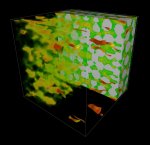Advanced Computing, Mathematics and Data
Research Highlights
April 2008
High-Performance Computing for the Planet's Hidden Realm

The image is a visualization of pore-scale flow simulation performed on PNNL's MPP2 supercomputer. White regions represent the solid grains of the porous medium and have been removed in the foreground portion of the image. Colored particles represent the moving fluid and colors represent the magnitude of local velocity, with red tones representing the largest velocities. Selected path lines are also shown. The simulation was performed by Bruce Palmer, Pacific Northwest National Laboratory, and the visualization was created by Chad Jones and Kwan-Liu Ma at the University of California at Davis and the SciDAC Institute for Ultrascale Visualization. Enlarged View
The subsurface—the realm hidden beneath the surface of our planet—remains a mysterious place with many opportunities for exploration. Physical, chemical and biological processes in the earth's subsurface are central players in many energy and environmental issues critical to the world's security and economy. High-performance computing will soon be brought to bear on understanding and predicting these processes across a wide range of time and space scales, according to Tim Scheibe, researcher at Pacific Northwest National Laboratory (PNNL).
Scheibe co-authored an article about the role of high-performance computing to address subsurface problems that was recently published in SciDAC Review.
According to Scheibe, a number of critical problems exist in subsurface science, particularly those relevant to the Department of Energy missions. These problems include energy production (hydrocarbons, geothermal), climate change and deep geological carbon sequestration, nuclear waste disposal, and legacy waste environmental contamination. "We focused our discussion in the article on the potential role of leadership-class computing in addressing these critical problems, particularly with attention to issues of physical scale and predictive capability of computational models," Scheibe said.
PNNL's subsurface project, "Hybrid Numerical Methods for Multiscale Simulations of Biogeochemical Processes" is featured in the article. In this project, researchers at PNNL are developing a hybrid multi-scale subsurface reactive transport modeling framework to integrate models with diverse representations of physics, chemistry and biology at different scales.
"In the near-term of five to ten years, the utility of this modeling capability will be primarily in development of scientific knowledge and design of physical experiments using a numerical experimentation approach," Scheibe said. "In the longer term, multiscale hybrid models implemented on high-performance platforms may supplant the current modeling approach and will significantly improve our ability to reliably predict field-scale phenomena and design remediation and other management approaches."
Acknowledgments
Sponsor: DOE's Office of Biological and Environmental Research and Office of Advanced Scientific Computing Research.
Research Team (PIs and co-PIs): Tim Scheibe (PNNL); Bruce Palmer (PNNL); Karen Schuchardt (PNNL); Alexandre Tartakovsky (PNNL); Paul Meakin (Idaho National Laboratory); George Redden (Idaho National Laboratory); Daniel Tartakovsky (University of California, San Diego).
EMSL Involvement: Some of this work was conducted in the Environmental Molecular Sciences Laboratory, a Department of Energy national scientific user facility located at the Pacific Northwest National Laboratory.


